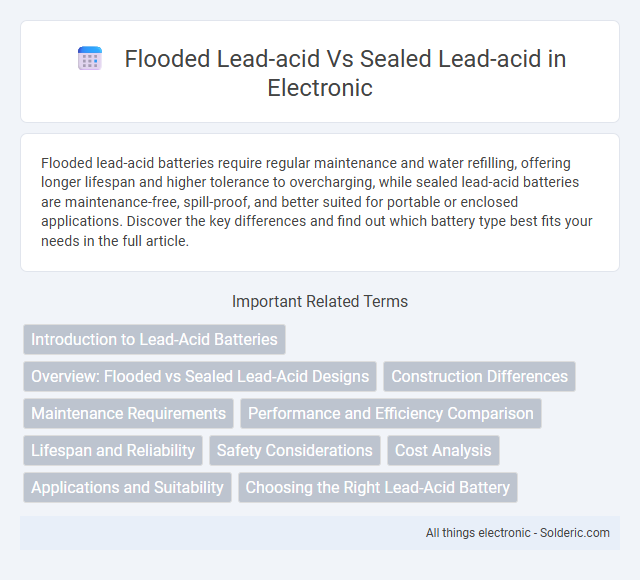Flooded lead-acid batteries require regular maintenance and water refilling, offering longer lifespan and higher tolerance to overcharging, while sealed lead-acid batteries are maintenance-free, spill-proof, and better suited for portable or enclosed applications. Discover the key differences and find out which battery type best fits your needs in the full article.
Comparison Table
| Feature | Flooded Lead-Acid Battery | Sealed Lead-Acid Battery (SLA) |
|---|---|---|
| Maintenance | Requires regular water refilling and inspection | Maintenance-free, no refilling needed |
| Ventilation | Needs proper ventilation due to gas release | Sealed design, minimal gas emission |
| Spill Risk | Higher risk of acid spillage | Spill-proof, safer in various orientations |
| Cost | Generally lower initial cost | Higher upfront cost |
| Lifespan | Longer cycle life under proper maintenance | Shorter lifespan compared to flooded |
| Usage | Common in automotive, solar, backup power | Used in UPS, emergency lighting, portable devices |
| Performance | Better tolerance to deep discharge | Limited deep discharge capability |
Introduction to Lead-Acid Batteries
Lead-acid batteries are widely used energy storage devices, primarily categorized into Flooded Lead-Acid (FLA) and Sealed Lead-Acid (SLA) types. Flooded Lead-Acid batteries contain a liquid electrolyte that requires regular maintenance, including water refilling, whereas Sealed Lead-Acid batteries use a gel or absorbed glass mat (AGM) electrolyte, making them maintenance-free and spill-proof. Both types rely on lead plates and sulfuric acid electrolyte for electrochemical reactions, but their design differences impact performance, lifespan, and application suitability.
Overview: Flooded vs Sealed Lead-Acid Designs
Flooded lead-acid batteries feature a liquid electrolyte that requires regular maintenance, including checking and refilling water levels, offering reliable performance in stationary and automotive applications. Sealed lead-acid batteries, also known as valve-regulated lead-acid (VRLA), use a gel or absorbed glass mat (AGM) electrolyte, providing a spill-proof, low-maintenance alternative ideal for portable and backup power solutions. Your choice depends on application needs, maintenance willingness, and safety considerations linked to each battery design.
Construction Differences
Flooded lead-acid batteries feature removable caps housing liquid electrolyte that requires regular maintenance, whereas sealed lead-acid batteries use immobilized electrolyte, either absorbed in a glass mat (AGM) or gelled, offering maintenance-free operation. The venting system also differs; flooded types have open vents for gas release, while sealed variants incorporate pressure relief valves to prevent leaks and contain gases internally. Understanding these construction differences helps you select the optimal battery type for your energy storage and power needs.
Maintenance Requirements
Flooded lead-acid batteries require regular maintenance, including checking electrolyte levels and topping up with distilled water to prevent damage and ensure optimal performance. Sealed lead-acid batteries, also known as valve-regulated lead-acid (VRLA) batteries, are maintenance-free and do not require electrolyte refilling or monitoring. Choosing sealed lead-acid batteries can save you time and effort by eliminating the need for routine inspections and fluid replenishment.
Performance and Efficiency Comparison
Flooded lead-acid batteries generally offer higher performance in terms of energy capacity and tolerance for overcharging, providing robust output for demanding applications. Sealed lead-acid batteries, while slightly less efficient in energy density, deliver superior maintenance-free operation and enhanced safety due to their sealed design that prevents acid spillage. Your choice depends on whether you prioritize maximum performance and regular upkeep with flooded types or prefer the convenience and safer handling of sealed lead-acid batteries.
Lifespan and Reliability
Flooded lead-acid batteries generally offer a longer lifespan, often exceeding 5 to 10 years with proper maintenance, due to their robust design and ability to be refilled with distilled water. Sealed lead-acid (SLA) batteries, including AGM and gel variants, provide enhanced reliability with minimal maintenance despite typically having a shorter lifespan of 3 to 7 years. The sealed design reduces the risk of acid leaks and corrosion, making SLAs preferable for applications requiring consistent performance and low upkeep.
Safety Considerations
Flooded lead-acid batteries require regular maintenance and ventilation due to the release of hydrogen gas, posing a higher risk of explosion and acid spills. Sealed lead-acid batteries, such as AGM and gel types, offer enhanced safety by being spill-proof and minimizing gas emissions, making them suitable for enclosed or sensitive environments. Proper handling and adherence to manufacturer guidelines are essential for both types to prevent accidents and ensure safe operation.
Cost Analysis
Flooded lead-acid batteries typically offer a lower upfront cost compared to sealed lead-acid batteries, making them more budget-friendly for large-scale energy storage projects. However, flooded lead-acid batteries require regular maintenance and water refilling, increasing long-term operational expenses. Sealed lead-acid batteries, while more costly initially, provide reduced maintenance costs and improved safety, potentially lowering total lifecycle expenses for Your applications.
Applications and Suitability
Flooded lead-acid batteries are commonly used in automotive, marine, and industrial applications where regular maintenance and electrolyte refilling are feasible, offering high tolerance to overcharging and deep discharges. Sealed lead-acid batteries (SLA), including Absorbent Glass Mat (AGM) and gel types, are preferred for backup power, UPS systems, and portable electronics due to their maintenance-free operation, reduced risk of acid leakage, and suitability for sealed, confined spaces. The choice between flooded and sealed lead-acid batteries depends on factors such as installation location, ventilation availability, and required lifespan under cycling conditions.
Choosing the Right Lead-Acid Battery
Choosing the right lead-acid battery depends on the specific application and maintenance preferences. Flooded lead-acid batteries offer high capacity and cost-effectiveness but require regular watering and maintenance to prevent acid stratification and corrosion. Sealed lead-acid (SLA) batteries, including Absorbent Glass Mat (AGM) and Gel types, provide maintenance-free operation, spill-proof design, and better resistance to vibration, making them ideal for sealed or portable applications.
Flooded lead-acid vs Sealed lead-acid Infographic

 solderic.com
solderic.com